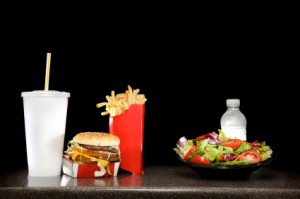
According to an American Journal of Public Health’s recent study, calorie guidelines, put in place to help educate people on the number of calories they should eat, don’t truly do the job they were meant to do.
Calorie guidelines, required in several states and cities in the United States, were designed to help people make better food choices and cut back on overconsumption. Congress is pushing for more calorie labeling in order to support health care reform, however, the effort may be futile.
Previous studies support the fact that listing calories has not done much for reducing America’s expanding waistlines. Fast food and restaurant food is extremely high in calories, and the industry has done very little to improve the nutrient value of their food. At present, almost one-quarter of our population eats fast food two or more times each week.
The most recent study’s author states that not much has changed since fast food outlets began providing calorie information to customers. She feels that the problem may rest in the fact that customers do not actually understand how to apply the information to their lives, without additional guidance. Perhaps eating a 1,000 calorie lunch seems perfectly normal to most people.
New York is one of the cities that requires calorie information about each item to be posted on menus. To test if teaching people how to use caloric intake information made any difference, a test of McDonald’s customers was conducted where one third were given a flyer that said women and men should limit their daily calories to between 2,000 and 2,400 per day, another group got flyers saying that a single meal should have no more than 800 calories, and a final group was given no information as all.
Food receipts and a post-meal survey were used for study data. Women who ate lunch consumed on average, 824 calories and men 890. This placed women consuming almost 30% more than the recommended amount of calories in one meal and men 11% more.
According to researchers, the calorie information did not make a difference in how customers ordered. Alarmingly, people who were given the guidelines ate almost 50 calories more than those without the guidelines.
Study leaders noted that people may just look at a burger, for instance and see that it is below the total recommended calories but forget to add in their drink and side which can add a considerable number of calories to any meal. It is unlikely that the drink would be water, and the side would be carrots.
Studies indicate that if you are really interested in gaining health you are best to avoid fast and processed food all together. JAMA Internal Medicine revealed that one meal from an independent small chain restaurant contained over 66% of an adult’s recommended daily calories. Another study found that sit down restaurant meals were comparable, containing 56% of the daily recommended calories in a single meal.
 Health experts believe that people may be more cautious if they saw how much they would have to work to burn off calories eaten. Research from an Experimental Biology class meeting in Boston in 2013 suggests that people who saw how much time it would take to burn off what they ate consumed 100 fewer calories than those who just saw the calorie amounts.
Health experts believe that people may be more cautious if they saw how much they would have to work to burn off calories eaten. Research from an Experimental Biology class meeting in Boston in 2013 suggests that people who saw how much time it would take to burn off what they ate consumed 100 fewer calories than those who just saw the calorie amounts.
Caution is advised, however as calories are not all equal and input and output are not always a good indicator of health. The best solution is to consume a diet high in whole nutritious foods, eliminate processed foods and stay active.
-The Alternative Daily

